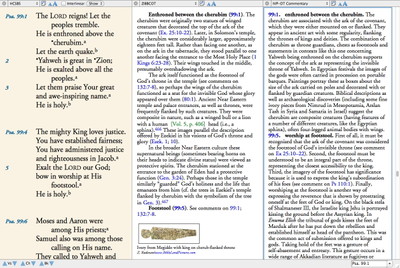This morning in my family’s devotions, we read Psalms 99 and 100 together. Psalm 99 calls the people to praise the Lord because of his sovereignty, justice, and holiness, while Psalm 100 calls them to celebrate the fact that he created them, that they belong to him, and that his love for them is eternal. The juxtaposition of these two psalms led me to discuss the difference between the concepts of God’s transcendence, which Psalm 99 focuses on, and his immanence, which is the focus of Psalm 100.
Interestingly, each of these psalms mentions different aspects of temple worship. Psalm 99 mentions that the LORD is “enthroned above the cherubim” and calls the people to “worship at his footstool.” Psalm 100 calls the people to “Enter His gates with thanksgiving and His courts with praise” (Psalm 100:4, HCSB). How often do we read these kinds of phrases and just think they sound poetic, without ever stopping to wonder what they mean? On those occasions when we do think to dig deeper, where can we turn to find out what they mean?
These days, one of the first places I turn when I come across passages like these are the Bible Background Commentaries published by Zondervan and InterVarsity Press. Unlike standard commentaries, which tend to focus on explaining a passage’s wording, background commentaries focus on explaining the historical and cultural background of the passage. In this case, we’re dealing with the mention of “cherubim” in relation to God’s throne, the mention of his “footstool,” and the mention of his “gates” and “courts.” While I could certainly look each of these terms up in a dictionary, that approach might give me a lot of information which is not directly relevant to my understanding of the passage. What’s more, I might not be able to piece together what I learn about each item to see how they all fit together. The advantage of a background commentary is that it offers a convenient summary of the background information you need to understand your passage of study.
So to understand these references to the temple, I simply opened the Zondervan Illustrated Bible Background Commentary on the Old Testament (ZIBBCOT) and the IVP Bible Background Commentary on the Old Testament in two parallel panes. Sure enough, both discuss the fact that the ark of the covenant, which represented God’s footstool, was placed beneath sculptures of two cherubim with their wings touching. First, the cover of the ark itself featured these cherubim, but in Solomon’s temple, the ark was also overshadowed by larger free-standing statues of cherubim. By reading these two commentaries, it becomes clear that the temple references in Psalm 99 refer to the Holy of Holies. These commentaries also discuss the “gates” and “courts” mentioned in Psalm 100, explaining that the temple itself was part of a larger complex of courtyards where the people could come and worship.
By reading a few short paragraphs of commentary conveniently displayed in parallel panes, we see that Psalm 99, which focuses on God’s transcendence, uses images of the Holy of Holies which only the high priest could enter. We likewise see that Psalm 100, which focuses on God’s nearness and covenantal love for his people, uses images of the temple courts where the people could come and worship. Thus, the people of God are called to draw near to God and celebrate their special relationship with him (Psalm 100), yet they are also reminded that they worship a God who “reigns,” whose dwelling place they can bow toward but not enter, and whose holiness inspires fear and trembling (Psalm 99).
As we say in the south, “That’ll preach!”
At the very least, it makes for one pretty cool family devotion.


